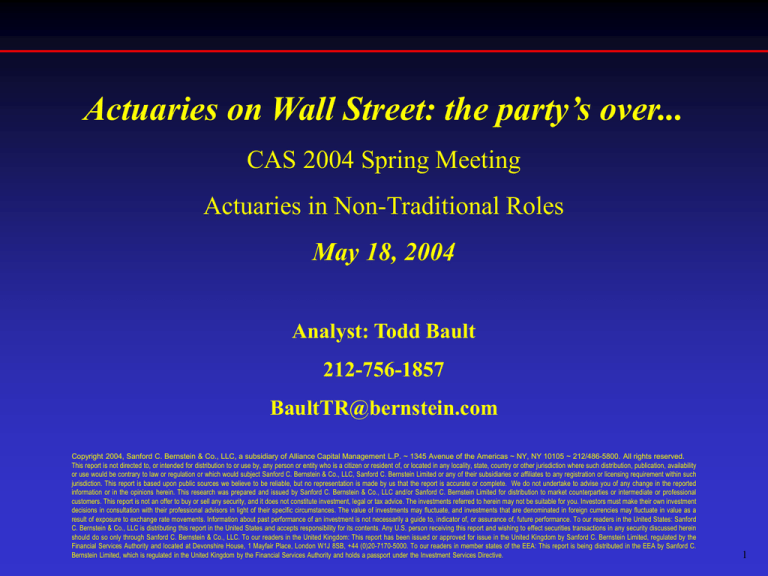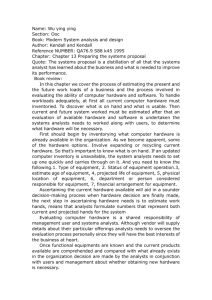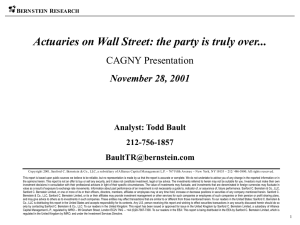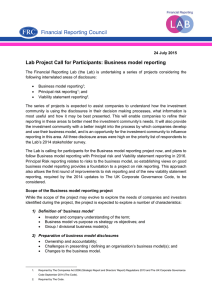Actuaries on Wall Street: the party’s over... CAS 2004 Spring Meeting
advertisement

Actuaries on Wall Street: the party’s over... CAS 2004 Spring Meeting Actuaries in Non-Traditional Roles May 18, 2004 Analyst: Todd Bault 212-756-1857 BaultTR@bernstein.com Copyright 2004, Sanford C. Bernstein & Co., LLC, a subsidiary of Alliance Capital Management L.P. ~ 1345 Avenue of the Americas ~ NY, NY 10105 ~ 212/486-5800. All rights reserved. This report is not directed to, or intended for distribution to or use by, any person or entity who is a citizen or resident of, or located in any locality, state, country or other jurisdiction where such distribution, publication, availability or use would be contrary to law or regulation or which would subject Sanford C. Bernstein & Co., LLC, Sanford C. Bernstein Limited or any of their subsidiaries or affiliates to any registration or licensing requirement within such jurisdiction. This report is based upon public sources we believe to be reliable, but no representation is made by us that the report is accurate or complete. We do not undertake to advise you of any change in the reported information or in the opinions herein. This research was prepared and issued by Sanford C. Bernstein & Co., LLC and/or Sanford C. Bernstein Limited for distribution to market counterparties or intermediate or professional customers. This report is not an offer to buy or sell any security, and it does not constitute investment, legal or tax advice. The investments referred to herein may not be suitable for you. Investors must make their own investment decisions in consultation with their professional advisors in light of their specific circumstances. The value of investments may fluctuate, and investments that are denominated in foreign currencies may fluctuate in value as a result of exposure to exchange rate movements. Information about past performance of an investment is not necessarily a guide to, indicator of, or assurance of, future performance. To our readers in the United States: Sanford C. Bernstein & Co., LLC is distributing this report in the United States and accepts responsibility for its contents. Any U.S. person receiving this report and wishing to effect securities transactions in any security discussed herein should do so only through Sanford C. Bernstein & Co., LLC. To our readers in the United Kingdom: This report has been issued or approved for issue in the United Kingdom by Sanford C. Bernstein Limited, regulated by the Financial Services Authority and located at Devonshire House, 1 Mayfair Place, London W1J 8SB, +44 (0)20-7170-5000. To our readers in member states of the EEA: This report is being distributed in the EEA by Sanford C. Bernstein Limited, which is regulated in the United Kingdom by the Financial Services Authority and holds a passport under the Investment Services Directive. 1 Agenda What I do (overview of institutional research) What I think (how to look at companies and stocks) What I recommend (to keep actuaries relevant) Warning: don’t tell me anything! Seriously, all communication regarding a company needs to be through Investor Relations (if you work for a mutual, gab away) If I hear inside information, I am “tainted” • • I cannot speak to anyone (including bosses) until information is disclosed They often send analysts away to remote places during tainted periods (not so bad— Bermuda ranks pretty highly) We can talk all day about the industry and general issues, or anything that I or a company have publicly disclosed Credits: Thanks to Bernstein’s CEO Lisa Shalett for some of the data and perspectives presented here 2 Todd R. Bault—quick bio Analyst background • Senior Research Analyst for Sanford C. Bernstein since 1999 • Named #3 non-life insurance analyst in the 2003 Institutional Investor poll Insurance background • Fellow of the Casualty Actuarial Society (FCAS 1994), Member of the American Academy of Actuaries and ASTIN • St. Paul Companies 1988-1998 Officer—Corporate Development: strategic planning, acquisition analysis Corporate Financial Actuary: rate of return analysis, acquisition valuation London Reinsurance: pricing, reserving, planning, strategy • Odyssey Reinsurance: 1998-1999 Senior Vice President & Chief Actuary Brought in by new CEO to help turn around company (then TIG Re) Developed new products, structured deals, helped set policy and strategy 3 Sanford C. Bernstein Was one of the last private partnerships (like Goldman) • And is no more (like Goldman)—bought by Alliance Capital in 2000 • Known for disciplined investment philosophy and rigorous hiring process • Recently made a case study of the Harvard Business School Asset management • • • • For pension funds, mutual funds, private clients $482 billion assets under management for Alliance in total Historic value focus (low P/E stocks), complements Alliance growth emphasis Private clients a Bernstein specialty Institutional research • What I do • Outsourced research for institutional clients (i.e. no retail, or individual investors) • Bernstein hallmark is detailed, unbiased research No investment banking (conflict of interest) Analysts from covered industry, not “The Street” Consistently ranked #1 overall for research quality and industry knowledge 4 Institutional investors Support services Buyside analysts Portfolio manager Buyside traders Institutional investors manage money for others Centers around the portfolio manager (PM), who makes the investment decisions • Mutual funds, pension funds, hedge funds, private clients • Called the “buyside”, as they buy the stock for their customers (retail investors) • Buyside analysts provide research and insight to the manager by sector, investment style, or individual stock • Traders execute the manager’s trading decisions • Vast network of support services: IT, admin, legal & compliance, etc. 5 Institutional research Support services Buyside analysts Portfolio manager Buyside traders Sellside analysts & sales force Sellside research Sellside traders Support services Institutional research is outsourced buyside research Generally viewed as more in-depth than is possible on the buyside Called the “sellside” because—well, good question! All functions are replicated, with many relationships between PMs, analysts, and traders Sellside sales force extremely important in providing visibility and relationships for analysts 6 Economics of a broker/dealer We make money from trades made by institutional investors • 4 cents a share and falling—compare to 8-30 cents for retail trades • We can be paid lots of ways Directly for specific trades based on recommendations Indirectly for overall advice provided (e.g. I pitch insurance, you buy IBM) These are soft dollars, currently the subject of some controversy • What broker/dealers provide for that 4 cents: Research and advice—the principal product of a sellside analyst Execution—some institutional trades are labor intensive and specialized Banking—taking companies public and giving clients access to IPOs Capital—commit capital behind clients to provide liquidity • Bernstein does not do the last two Banking is a conflict of interest to research Example: most 1998-2000 tech research was secondary to the deals, and is considered highly suspect by many clients Capital commitment enhances banking and other relationships We are still paid the full 4 cents—earned with high-quality research 7 Deregulation has driven commissions down $ 0.30 $ 0.25 $ 0.15 $ 0.10 $ 0.05 2000 1998 1996 1994 1992 1990 1988 1986 1984 1982 $ 0.00 1980 CPS $ 0.20 8 Sellside analysts We perform three key functions (the Mahedy list): • Recommend stocks Estimate earnings, set target prices, and make stock recommendations Great stock-picking desirable, but not necessary (often leads to being PM) • Provide detailed research on industries and companies Build company models, conduct industry studies, talk to industry players Many ways to do this successfully: Quantitative/technical approaches that talk about stock behavior Qualitative/fundamental approaches about company/industry behavior Dig up good company dirt (hedge funds are masters of this) Best approach combines all of these to some degree • Act as “thought partners” for clients Perhaps the most valuable service we provide In the end, PMs pick stocks, not analysts, so just picking our brains to gain comfort with their own intuition is extremely important 9 What’s important to investors? Making money—period • • • • Investors buy stocks, not companies (sorry, Mr. Buffett) They buy stocks if they think the price will go up They sell stocks if they think the price will go down Stocks that don’t move are bad Understanding companies is a means to making money • If there were another way, they’d use it, and many do (e.g. technical analysis, quantitative analysis) • So investors will never care as much about an industry or company as an analyst • As a sellside analyst, you are an expert they consult to help them make money in stocks from your industry Not easy—investors are a VERY smart bunch! 10 What matters to investors in non-life insurance? Pricing, pricing, pricing • • • • The #1 concern: one could talk about nothing but this and be fine This despite the fact that pricing can’t easily be measured by investors Investors buy ahead of price increases, and far ahead of earnings Supply-focused, as demand is viewed as fairly constant (erroneous?) Quality of balance sheet and financials • Loss reserves a big concern, very hard for outsiders to analyze But relationship of reserves and earnings not well understood by some • Capital adequacy matters for ratings, ability to bear risk But the flip side is the dreaded “excess capital” problem Qualitative factors (i.e. what actuaries allegedly ignore) • Insurance is so difficult to analyze that these take on added value • Quality of management, market share, business profile are examples 11 How do investors value insurance companies? Discounted cash flow • Our preferred method: takes into account all economic factors • A properly managed DCF model serves as a valuation anchor • But many investors don’t like the complexity or parameter sensitivity Price/book • Best surrogate for DCF, and used with many other financial stocks • Stocks often trade in a range of P/B, with a premium for future earnings • Not as useful for comparing companies (capital structure matters) Price/earnings • #1 valuation tool for stocks generally, so it matters • Mostly understood that P/E less useful for insurance given volatility • P/E could be more useful if normalized, but then why not use DCF? P/E is in fact a very quick and dirty DCF model 12 What the insurance industry thinks of stock analysts Day by Day (The Analyst’s Song) Day by day, Week by week, Quarter by quarter, Three things we seek: To keep the top line growin’, To keep the cash flow flowin’, Prevent the loss reserves from glowin’ So the analysts will cheer. Month by month, Year by year, They think our business is linear, Well, we can’t out shrewd ‘em And we can’t subdue ‘em, So we’ll smother ‘em with b***s*** and delude ‘em every Day by day, by day by day, by day by day, by day by day, by day by day, by day! Words by Mark Hinkley Sung to the tune “Day by Day” by Stephen Schwartz 13 Pressure on Wall Street and analysts has been huge Spitzer, Global Settlement and “Dis-honoring” of the Analyst Profession 2002 / Q1 2003 Bear Market Hangover Trading Technology Onslaught Institutional Equities FSA Elimination of “Soft Dollars”; Baker/Oxley MF 2420 NYSE-Specialist Investigations; Strategic Turmoil at NASDAQ Rising Regulatory Scrutiny Analyst Disclosures, Certifications etc. 14 Was the scrutiny of analysts deserved? We consult the wisdom of the ages: NO! YES! A bit! A bit! Let’s flesh out each of these points a little further… 15 Scrutiny of analysts: the case for NO The real problem—roles morphed during the “bubble”: • • • • Corporate CEOs Portfolio Managers Research Analysts Investors = = = = Rock stars Magicians Celebrities Customers Traditional roles gradually returning: • • • • Corporate CEOs Portfolio Managers Research Analysts Investors = = = = Managers, resource allocators Professional investors Analysts Shareholders The mathematics of research deceptively simple • Conflicts of interest ≠ Bad (bankers have their uses) • Independence ≠ Good (Good = Good, surprisingly) • Wrong ≠ Corrupt (human beings reward/punish a lot of randomness) 16 Scrutiny of analysts: the case for YES Analysts were at their worst during the “bubble”: • Analysts helped investors, issuers, proprietary traders, investment bankers, and the media… • “Tell stories” about their stock picks… • Utilizing every communication mode possible (i.e. “marketing”)… • Employing a plethora of valuation paradigms & ratings systems… • Based on all kinds of company analysis, including “management guidance”… • Trying to “win at the polls” For this questionable behavior, which still exists, analysts: • Are paid a fortune… • Wield extraordinary power, and… • Cultivate enormous hubris Those with the power need and deserve the scrutiny! 17 Scrutiny of analysts: the case for “a bit” Good research and analysts matter: • Only 20% of stocks outperform, 50% of said performance in 1 month! • Good analysis tells investors where to be, what to avoid • Bernstein hopefully proves that deep knowledge and ethics can pay Reasonable regulations enhance trust in the system: • The “bubble” happened, and people got hurt • Capitalism can be driven to excesses without supervision • Face it—lots of money can attract bad & dumb elements 18 So you want to be a millionaire…ah, stock analyst? Can actuaries do this job? • I’ll let you know for sure in a couple of years • Yes, of course—this is a great application of actuarial skills, even outside of covering the insurance industry Should actuaries look at non-insurance options? • Absolutely—our modeling skills and general risk training are applicable in any industry, suitably adapted • Actuaries should also pursue broader roles in insurance companies Should actuaries supplement their training (CFA, MBA)? • Only if you want the credentials—they are not necessary • But either would probably be well-received by “The Street” So, can I be a millionaire as an analyst? • I’ll let you know for sure in a couple of years 19 How to keep actuaries relevant Good work only matters if it’s used: • Actuarial work (and good equity analysis) is complex—it must be oversimplified for non-experts to use • If you do this, you will be appreciated beyond belief: E.g. My salesforce amplifies my message 50 times, but only if I create a message they can sell They don’t need nuanced reality—they need to get clients to want to talk to me (I then give them nuanced reality) • If you don’t do it, someone else will do it—they will be appreciated and you will be ignored (at best) or resented (at worst) I’m afraid it IS all about the money: • • • • Your job is to help your company make money, not to fit cool models Your goal: show how fitting cool models makes the company money If fitting cool models doesn’t do this, figure out what does By the way, I like fitting cool models, too, and it can pay! 20 ® 21






